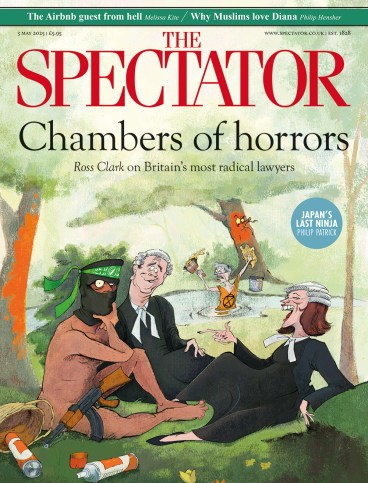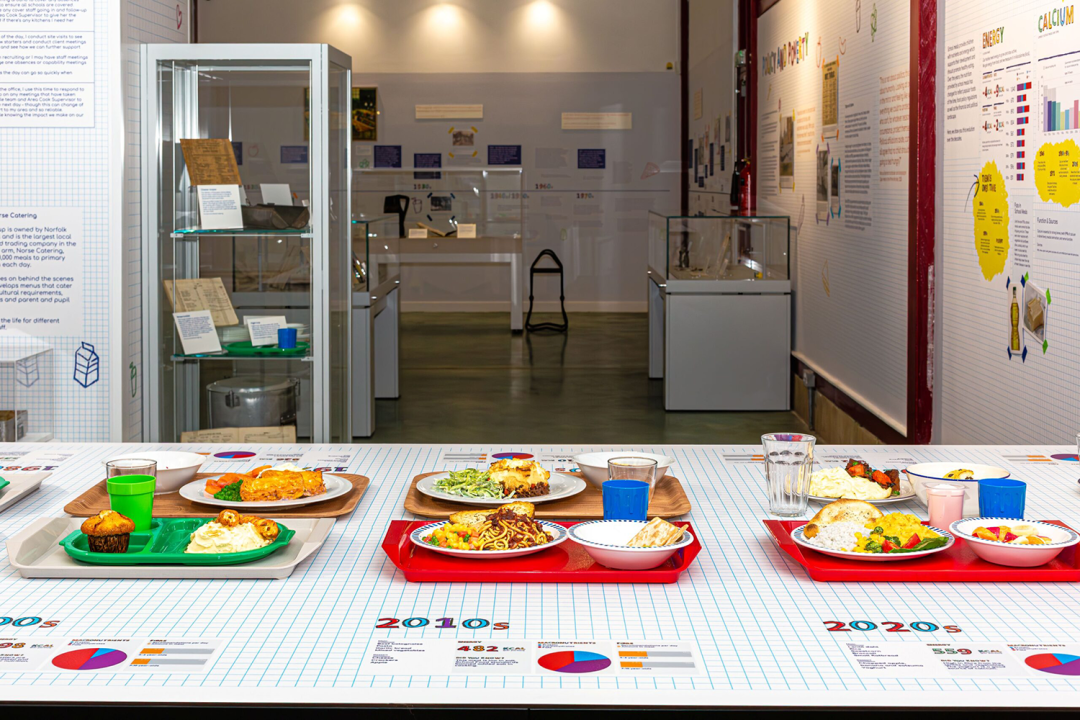
Ysenda Maxtone Graham has narrated this article for you to listen to.
If your stomach turns when you walk past a Japanese restaurant with moulded plastic replicas of sushi on display, prepare to feel even more nauseous in the School Dinners exhibition at the Food Museum in Stowmarket, Suffolk. Here, moulded in that same plastic, in (if anything) even more garish colours, you’ll see a sample two-course school dinner from each decade from the 1940s to the 2020s. If orange PVC cod’s roe looks a bit disgusting, a heap of pale, lumpy, plastic 1970s mashed potato with over-boiled carrots is even worse.
The sample plate from the 1940s contains chunks of dark brown liver polluting the inside of a jacket potato. (I’m not sure dinner ladies would have put liver inside a jacket potato in the 1940s.) The 1970s beige spam fritters look like flaccid inflatable beds. By the 1980s, the plastic flight tray had come into fashion, so while eating their greasy sausages with mash and peas, children were distracted by the chocolate sponge with pink custard in a separate division of the same receptacle. By the 1990s the turkey twizzler was ruining children’s health, resting on a bed of vomity ‘mixed vegetables’ (carrot cubes, peas and sweetcorn) with, again, the scoop of mash which, in plastic form, looks like vanilla ice cream. By comparison, the lentil dahl of the 2020s, with rice, sweetcorn and a small flatbread, followed by fruit salad and a pot of yoghurt, looks bearable.
Beware the onslaught of wall prose. I go to an exhibition to look at items, not to read wall prose. When you enter the exhibition, housed (appropriately) in the Bone Building on the glorious 84-acre site of the Food Museum – which used to be the Museum of East Anglian life but was rebranded in 2022 – you’re accosted by bite-size chunks of educational prose lining every wall. To make it palatable, they’ve chosen a font with no sharp angles on the letters. This doesn’t make it any more enjoyable. It’s a slog. You learn about (for example) the 1906 Education (Provision of Meals) Act, the Milk in Schools Scheme of 1934, and the ending of free milk for over-sevens in 1970 when Margaret Thatcher was education secretary (the expression ‘Thatcher, Thatcher, milk snatcher’ is quoted twice, on two different walls). But millions of us are positively grateful to her for removing the dreaded third-of-a-pint of sun-warmed milk from break times.
There’s a great deal about the evolving politics of the eligibility for free school meals, Marcus Rashford’s campaign during the pandemic, and Jamie Oliver’s push to get rid of turkey twizzlers. Get me to the stuff! Will this exhibition even scrape the surface of the essence of what most of us remember about school food: that much of it was revolting, designed to toughen your character, but not to give any pleasure?
Strangely – there having been no mention in the wall text even of the existence of private schools – the first display case consists of a wooden ‘trencher’, a black leather jug for small beer, and a 1719 buttery account, all from Eton. In a nearby case, there’s a half-pint jug and a cutlery set from the Foundling Hospital, and, in another, a selection of brightly coloured plastic lunch boxes. Not scratching the surface yet. It occurred to me that this is quite a tricky exhibition to put together. School food is so vivid in all our memories – most of us can smell Friday-fish mornings to this day and recall the thick skin on the custard – but it was probably rarely photographed.
A few delightful pictures of dinner ladies (official title: ‘ancillary lunchtime supervisors’) were taken. It’s a joy to celebrate those smiling ladies, and there’s a line-up of their evolving uniforms. Jeannette Orrey, the celebrated dinner lady from Nottinghamshire, has lent her MBE medal.
We get a bit closer to the essence of the food itself in some of the recipes on display: for example one for ‘Dutch Rolls’ (meatballs), which starts with ‘14lb of chuck steak or clod and sticking’, whatever that is. There’s a terrifying cylindrical metal pudding tin from Hitchin Girls’ Grammar, which brings to mind the jam roly-poly known as ‘dead man’s leg’.
A wartime education authority list of guidelines states: ‘The steaming of vegetables even in the best equipment is not as satisfactory as cooking them in water.’ And: ‘Outer leaves contain most vitamins and should not be thrown away.’ Hence the bitter, dark, over-boiled cabbage that carried on well into the 1970s. Wonderfully, you can taste those boiled greens at the exhibition, offered to visitors in tiny samples, along with a cube of ‘cheese flan’, and, for pudding, a square of chocolate stodge smothered in chocolate custard.
In the museum café, you can have a full ‘1990s school dinner’ for £14: pizza with chips and sweetcorn, followed by sprinkle cake and pink custard. I decided to wait for a 2020s sandwich on the Greater Anglia train.








Comments